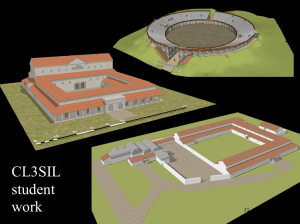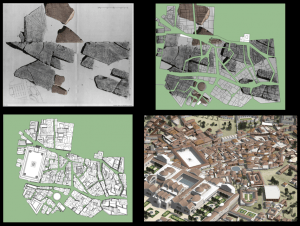Last week we hosted Dr Matthew Nicholls of the department of Classics at the University of Reading. He came to talk as part of our HEA-funded Making Digital History project to an audience of historians of all periods about digital modelling of the ancient Roman world, something he’s been working on for more than five years. Matthew has created a digital model of the ancient city of Rome using the online tool SketchUp, which is free and allows users to build accurate 3D digital models. After the talk Matthew showed me the tool and although he’s an expert, it didn’t seem to difficult (or maybe the sort of thing you could pick up quite well after a few hours of playing around with it and making mistakes).
Matthew is now working with undergraduate students on a third year module called Digital Silchester, in which students are expected to learn to use the SketchUp tool and then to make their own models based on buildings that Reading’s Archaeology department have excavated at Silchester, a Roman city not far from Reading.The students have to produce a written commentary to accompany their digital object and it’s here where they have to engage further with the scholarship on Silchester and on Roman cities and architecture more generally. They have to justify the choices that they have made when recreating buildings for which we have only partial evidence (e.g. little more than a floor plan, perhaps). The students have to explain the reasoning behind their choice of architectural features through reference to other primary sources such as written accounts of buildings from elsewhere in the former Roman Empire. This seems to me to be an exciting and innovative project that builds up (literally, or maybe digitally is more accurate!) students knowledge as Roman historians/ Classicists at the same time as enabling them to develop their ability to think visually, to make connections between literary and archaeological/architectural sources, and to rationalise their decisions with reasoned use of evidence.
I hope that we might be able to build on Matthew’s work here at Lincoln, taking advantage of the city’s rich Roman and medieval heritage to develop our students understanding of the relationship between history and place. Hopefully we’ll invite Matthew back to help us some more.


Comments are closed.